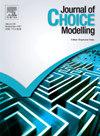Context-aware Bayesian mixed multinomial logit model
IF 2.8
3区 经济学
Q1 ECONOMICS
引用次数: 0
Abstract
Traditional choice models often entail the assumption that the preference parameters of the decision-maker are constant throughout time and across different choice situations, which may be too strong for certain choice modelling applications. This paper proposes an effective approach to model systematic, context-dependent heterogeneity, thereby introducing the concept of the context-aware Bayesian mixed multinomial logit model (C-MMNL). In this model, a neural network maps contextual information to interpretable shifts in the preference parameters of each individual in each choice occasion. The proposed model offers several key advantages. First, it supports both continuous and discrete variables, as well as complex non-linear interactions between both types of variables. Secondly, each context specification is considered jointly as a whole by the neural network, rather than each variable being considered independently. Finally, since the neural network parameters are shared across all decision-makers, it can leverage information from other decision-makers to infer the effect of a particular context on a particular decision-maker. Even though the context-aware Bayesian mixed multinomial logit model allows for flexible interactions between attributes, the increase in computational complexity is minor, compared to the mixed multinomial logit model. We illustrate the concept and interpretation of the proposed model in a simulation study. We furthermore present a real-world case study from the travel behaviour domain — a bicycle route choice model, based on a large-scale, crowdsourced dataset of GPS trajectories including 119,448 trips made by 8555 cyclists.
上下文感知贝叶斯混合多项逻辑模型
传统的选择模型通常需要假设决策者的偏好参数在整个时间和不同的选择情况下是恒定的,这对于某些选择建模应用可能太强了。本文提出了一种有效的方法来模拟系统的、上下文相关的异质性,从而引入了上下文感知贝叶斯混合多项逻辑模型(C-MMNL)的概念。在这个模型中,神经网络将上下文信息映射到每个个体在每个选择场合的偏好参数的可解释变化。提出的模型提供了几个关键的优点。首先,它支持连续变量和离散变量,以及两种变量之间复杂的非线性相互作用。其次,神经网络将每个上下文规范作为一个整体来考虑,而不是单独考虑每个变量。最后,由于神经网络参数在所有决策者之间共享,它可以利用来自其他决策者的信息来推断特定上下文对特定决策者的影响。尽管上下文感知的Bayesian混合多项logit模型允许属性之间灵活的交互,但与混合多项logit模型相比,计算复杂性的增加很小。我们在模拟研究中说明了所提出模型的概念和解释。我们进一步提出了一个来自旅行行为领域的现实案例研究——一个自行车路线选择模型,该模型基于一个大规模的、众包的GPS轨迹数据集,包括8555名骑自行车的人的119,448次旅行。
本文章由计算机程序翻译,如有差异,请以英文原文为准。
求助全文
约1分钟内获得全文
求助全文

 求助内容:
求助内容: 应助结果提醒方式:
应助结果提醒方式:


